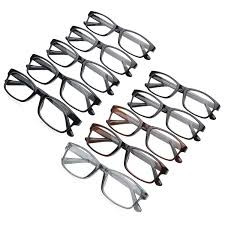
Vision has implications on health, quality of life and sustainable development and yet many people fail to access quality eye care services mainly due to the high cost of services and spectacles.
The Lancet Global Report on Eye Health (2021) estimates 510 million people who have uncorrected near vision impairment because of not having spectacles.
Uncorrected Refractive Errors (URE) are a leading cause of avoidable blindness in Zimbabwe.
According to National Eye Health Strategy (2021 – 2025), refractive error is a significant burden and a major cause of moderate visual impairment on the national population for both children and adults.
The National Assistive Technology Strategy for Zimbabwe (2024-2025) and Assistive Products Priority List considers spectacles as an important assistive device that is also used in the context of vision rehabilitation with the aim of maintaining improved functioning and independence.
For those with low vision, spectacles are a fundamental component of rehabilitation that enables the use of residual vision, development of skills and managing daily activities.
Prioritisation of spectacle wear in public health initiatives has been limited due to several factors that include perceived non-urgence compared to other health issues, limited health budgets that focus on life-threatening health conditions, cultural and social barriers which lead to resistance and inadequate infrastructure.
Refractive errors which include near-sightedness, farsightedness or both (astigmatism) cause blurry vision, headaches or fatigue when viewing objects at close distance, excessive squinting, glare from light and poor night vision among other effects.
- Perspectives: Focus on diabetic eye disease
- Glaucoma the thief of sight
- Crucial role of eye health in children’s development
- Retinoblastoma in Zim and the need to expand access to eyecare
Keep Reading
Without spectacles mild or moderate visual impairment can significantly affect an individual’s cognitive, social and economic well-being.
While spectacles are a common intervention to address refractive error, a large proportion of those affected in low to medium income countries such as Zimbabwe cannot afford the high cost of payments for services and spectacles.
The high cost of spectacles is influenced by several factors which include scarcity of optical services especially in rural areas, imported spectacles that incur significant duties and taxes, absence of local production facilities and lack of awareness.
Understanding health insurance policy for vision benefits is important as some insurers limit the benefits leading to partial coverage or co-payments.
A common misconception is that eyesight deteriorates with spectacles while others are of the perception that spectacles are meant for the aged.
It is essential to wear prescribed spectacles/glasses for correction to address the struggles such as reading or driving.
Mild refractive errors can benefit from spectacles especially for reducing eye strain.
Specific eye conditions will require people to wear their spectacles all the time to address the blurry vision and distance vision.
Wearing spectacles does not weaken eyesight overtime but will improve the vision making it easier to tackle daily activities.
As people age their eyesight naturally deteriorates due to eye conditions such as presbyopia (difficulty focusing on close objects).
Spectacles will assist the elderly to reduce the risk of falls, reduce discomfort from strained vision, boost their confidence in engaging socially and other daily activities.
Vision problems can limit career opportunities or affect employee performance therefore, regular eye examinations will ensure the workforce accesses the right prescription and prevents long-term vision problems.
A clear vision enables employees to work efficiently and be more productive.
Many jobs require prolonged screen use and proper eyewear can reduce digital eye strain and headaches.
Digital strain is common from the prolonged use of digital devices like computers and mobile phones.
Due to the increase in screen time, addressing digital strain has become essential.
Spectacles can be customised to minimise glare from screens, filter light and potentially reduce discomfort.
Additional strategies such as taking regular breaks from the screen, blinking exercise and positioning screens at eye level to maintain viewing distance can reduce strain.
While some childhood vision problems may improve as they grow, most refractive errors such as myopia tend to progress.
Evidence shows that children with uncorrected vision have problems reading or writing leading to poor academic performance.
Eye strain and headaches from uncorrected vision can make it hard for the child to remain focused.
Therefore, providing spectacles to children improves their educational performance, social interaction, minimises risks of accidents and improves the quality of life.
Spectacle adherence is important particularly for children to achieve effective coverage for refractive services.
Hence some of the reasons for not consistently wearing spectacles associated with cosmetology of spectacle wear or stigma can be addressed through awareness and providing a range of frames that are acceptable.
Guidance should be provided in choosing frame colours and styles that complement the overall look of an individual.
Recommendations
Developing models that increase the population demand for spectacles, will increase access to quality refraction services and affordable spectacles.
Cost effective strategies for vision screening of school children should be incorporated into the school health programs of the ministries of health and education.
The provision of refractive services and spectacles through school-based programs will increase access and uptake.
Counselling services in education settings should give support to spectacle wearers who may encounter unfavourable attitudinal feedback from their peers.
Transitioning to wearing of spectacles can be a challenge hence counselling can provide a supportive environment and better adaptation to spectacle wear.
While the provision of ready-made spectacles can meet the needs of at least 80% of the population with uncorrected refractive error, customized spectacles are a necessity for the 20% who are either bi-focal or multi-focal and these still need to be made affordable.
It is important to educate society about the importance of wearing spectacles and taking care of them.
Eye health education will enable the early identification and referral of individuals struggling with poor vision.
Education will ensure that individuals understand how to use their spectacles leading to improved vision.
Private-public partnerships are essential for providing cost-effective and accessible eye wear solutions especially in underserved populations.
Addressing such challenges associated with access to spectacles requires a multifaceted approach which promotes local production, reduces taxes on assistive technology and raising awareness on the importance of eye health.
The establishment of vision centres, outreach programs and the implementation of subsidised programs that offer affordable or free spectacles will ensure wider coverage.
The provision of spectacles is a simple cost-effective way to improve the quality of life and overall wellbeing hence the government interventions should ensure that all citizens regardless of income could maintain good vision.
*Tigere* is a development practitioner and writes in her personal capacity.
These weekly articles published in the Zimbabwe Independent are coordinated by Lovemore Kadenge, managing consultant of Zawale Consultants (Private) Limited, past president of the Chartered Governance & Accountancy Institute in Zimbabwe. Email – kadenge.zes@gmail.com or mobile No. +263 772 382 52










